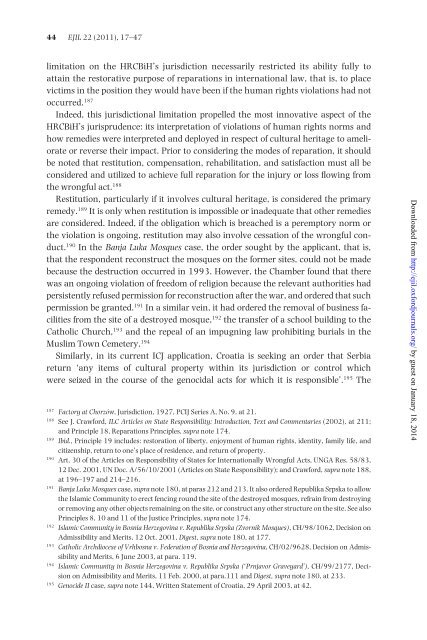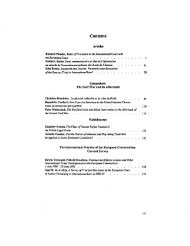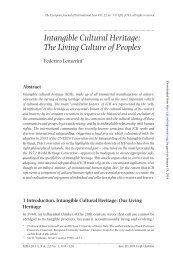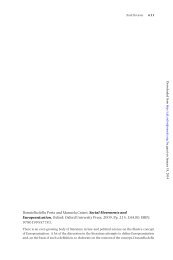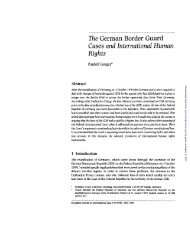Genocide and Restitution - European Journal of International Law
Genocide and Restitution - European Journal of International Law
Genocide and Restitution - European Journal of International Law
Create successful ePaper yourself
Turn your PDF publications into a flip-book with our unique Google optimized e-Paper software.
44 EJIL 22 (2011), 17–47<br />
limitation on the HRCBiH’s jurisdiction necessarily restricted its ability fully to<br />
attain the restorative purpose <strong>of</strong> reparations in international law, that is, to place<br />
victims in the position they would have been if the human rights violations had not<br />
occurred. 187<br />
Indeed, this jurisdictional limitation propelled the most innovative aspect <strong>of</strong> the<br />
HRCBiH’s jurisprudence: its interpretation <strong>of</strong> violations <strong>of</strong> human rights norms <strong>and</strong><br />
how remedies were interpreted <strong>and</strong> deployed in respect <strong>of</strong> cultural heritage to ameliorate<br />
or reverse their impact. Prior to considering the modes <strong>of</strong> reparation, it should<br />
be noted that restitution, compensation, rehabilitation, <strong>and</strong> satisfaction must all be<br />
considered <strong>and</strong> utilized to achieve full reparation for the injury or loss flowing from<br />
the wrongful act. 188<br />
<strong>Restitution</strong>, particularly if it involves cultural heritage, is considered the primary<br />
remedy. 189 It is only when restitution is impossible or inadequate that other remedies<br />
are considered. Indeed, if the obligation which is breached is a peremptory norm or<br />
the violation is ongoing, restitution may also involve cessation <strong>of</strong> the wrongful conduct.<br />
190 In the Banja Luka Mosques case, the order sought by the applicant, that is,<br />
that the respondent reconstruct the mosques on the former sites, could not be made<br />
because the destruction occurred in 1993. However, the Chamber found that there<br />
was an ongoing violation <strong>of</strong> freedom <strong>of</strong> religion because the relevant authorities had<br />
persistently refused permission for reconstruction after the war, <strong>and</strong> ordered that such<br />
permission be granted. 191 In a similar vein, it had ordered the removal <strong>of</strong> business facilities<br />
from the site <strong>of</strong> a destroyed mosque, 192 the transfer <strong>of</strong> a school building to the<br />
Catholic Church, 193 <strong>and</strong> the repeal <strong>of</strong> an impugning law prohibiting burials in the<br />
Muslim Town Cemetery. 194<br />
Similarly, in its current ICJ application, Croatia is seeking an order that Serbia<br />
return ‘any items <strong>of</strong> cultural property within its jurisdiction or control which<br />
were seized in the course <strong>of</strong> the genocidal acts for which it is responsible’. 195 The<br />
187<br />
Factory at Chorzów, Jurisdiction, 1927, PCIJ Series A, No. 9, at 21.<br />
188<br />
See J. Crawford, ILC Articles on State Responsibility: Introduction, Text <strong>and</strong> Commentaries (2002), at 211;<br />
<strong>and</strong> Principle 18, Reparations Principles, supra note 174.<br />
189<br />
Ibid., Principle 19 includes: restoration <strong>of</strong> liberty, enjoyment <strong>of</strong> human rights, identity, family life, <strong>and</strong><br />
citizenship, return to one’s place <strong>of</strong> residence, <strong>and</strong> return <strong>of</strong> property.<br />
190<br />
Art. 30 <strong>of</strong> the Articles on Responsibility <strong>of</strong> States for <strong>International</strong>ly Wrongful Acts, UNGA Res. 58/83,<br />
12 Dec. 2001, UN Doc. A/56/10/2001 (Articles on State Responsibility); <strong>and</strong> Crawford, supra note 188,<br />
at 196–197 <strong>and</strong> 214–216.<br />
191<br />
Banja Luka Mosques case, supra note 180, at paras 212 <strong>and</strong> 213. It also ordered Republika Srpska to allow<br />
the Islamic Community to erect fencing round the site <strong>of</strong> the destroyed mosques, refrain from destroying<br />
or removing any other objects remaining on the site, or construct any other structure on the site. See also<br />
Principles 8, 10 <strong>and</strong> 11 <strong>of</strong> the Justice Principles, supra note 174.<br />
192<br />
Islamic Community in Bosnia Herzegovina v. Republika Srpska (Zvornik Mosques), CH/98/1062, Decision on<br />
Admissibility <strong>and</strong> Merits, 12 Oct. 2001, Digest, supra note 180, at 177.<br />
193<br />
Catholic Archdiocese <strong>of</strong> Vrhbosna v. Federation <strong>of</strong> Bosnia <strong>and</strong> Herzegovina, CH/02/9628, Decision on Admissibility<br />
<strong>and</strong> Merits, 6 June 2003, at para. 119.<br />
194<br />
Islamic Community in Bosnia Herzegovina v. Republika Srpska (‘Prnjavor Graveyard’), CH/99/2177, Decision<br />
on Admissibility <strong>and</strong> Merits, 11 Feb. 2000, at para.111 <strong>and</strong> Digest, supra note 180, at 233.<br />
195<br />
<strong>Genocide</strong> II case, supra note 144, Written Statement <strong>of</strong> Croatia, 29 April 2003, at 42.<br />
Downloaded from http://ejil.oxfordjournals.org/ by guest on January 18, 2014


